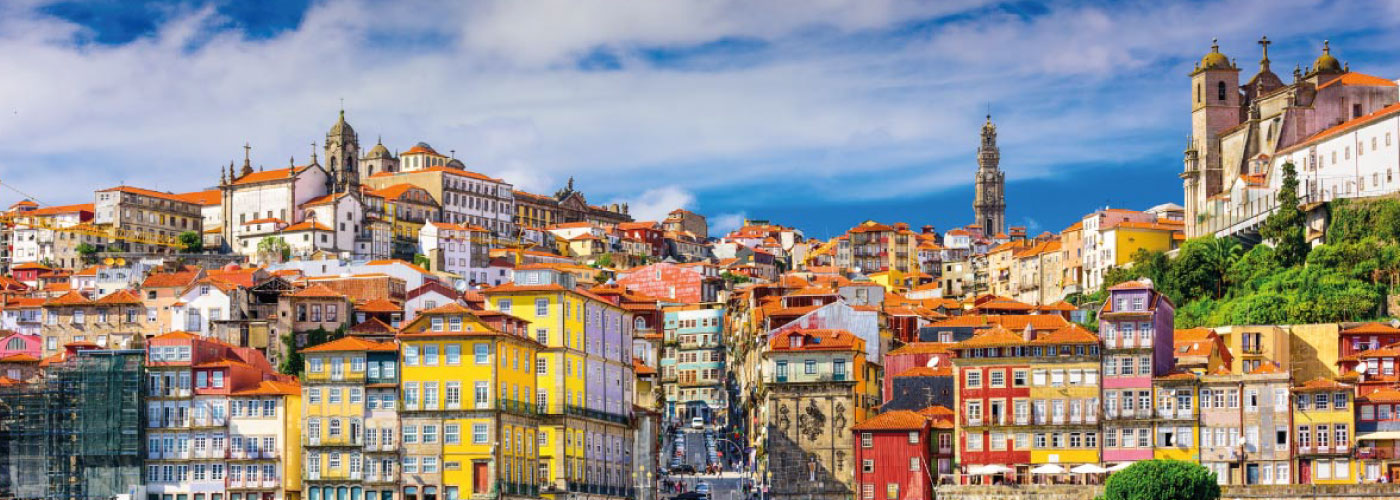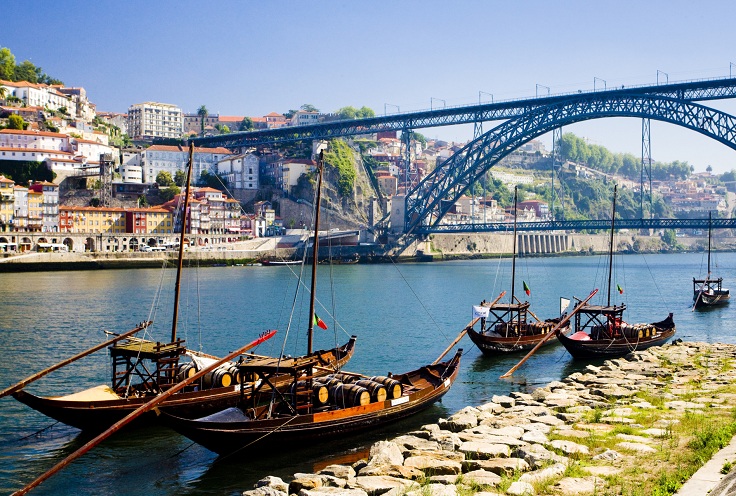Local Information
About Porto

The conquest of Portucale in 868 by Vímara Peres, a warrior of king Afonso III from Leon, is duly considered as a major event in the ancient history of Porto. Ever since the second half of the 6th century, since the days of the Suevians, the head office of the Portugalense Diocese was located in Portucale. However, as of 868 its importance increased: it became the centre of the movement of re-conquest, which, because of this, became the Portugalensis province in the middle of the 10th century. The inhabitants of this area became known as the Portugalenses. It was among them that the first vague national feelings began to emerge.
In 1120, D. Teresa, the widow of the Count D. Henrique, donated the Bishop D. Hugo and his successors the little borough of Porto. In 1123 the Bishop granted the latter a code of laws and later, D. Afonso Henriques confirmed and enlarged the limits of the land. In 1147 some of the Nordic Crusaders who took part in the Second Crusade entered the Douro river. The Bishop of Porto, D. Pedro Pitões, eloquently lectured them at the Crasto de Portucale, on top of the hill, in front of the Sé (Cathedral). The purpose of this lecture was to encourage them to join D. Afonso Henriques in the conquest of Lisbon. Afterwards, the Portugalense Bishop accompanied the armada and took part in the military adventure.
Porto began to develop rapidly when the Princess of the Tagus fell into the hands of the Christians. The population began to grow and so did the city’s economic importance. The bourgeois got involved in quarrels and clashes with its Bishops, to whom the borough owed so much, but yet from whose temporal subordination the rebellious ones wanted to free themselves. The King was often the peacemaker and it was D. João I, who, after two centuries, ended these quarrels, allowing himself the purchase of the right to temporal jurisdiction of the borough from the Bishops.
During the crisis of 1383-1385, Porto served the Master ofof Avis, who presented himself as the Portugal Governor and Defender against the people of Castile, in such a way that the monarch granted it the title of MUI NOBRE E SEMPRE LEAL CIDADE (very noble and always loyal city). The time of the Cycle of Conquests and the Ultramarine Discoveries followed. In the same manner that the north of the country had been the cradle of the warriors who conquered the south from the Moors, it was also from the north, place of birth of the Porto Infante D. Henrique (Henry the Navigator), and many sailors, that a decisive impulse towards great maritime navigations emerged. However, there was more to Porto than trade and navigation.
After having been under the rule of the king Philip of Spain, Portugal recovers its independence in 1640. At this point, Porto enthusiastically takes on a role of distinction during the Restoration. Porto suffers severely from the invasion of Soult in 1809, and its tragic consequences.
Nevertheless, not everything is related to war in the history of Porto. On the second half of the 18th century, the city, which had become extraordinarily rich, grew, became modernized thanks to the Almadas; and in the 19th century, Porto presented the Nation with poets like Garrett and sculptors as great as Soares dos Reis.
Obviously, at the groundwork of all collective actions of a people is the people itself. Guilherme Camarinha bore that in mind in a tapestry displayed at the Câmara Municipal do Porto (Porto City Council), as he placed at the base of his amazing work the farmers, the craftsmen, the carpenters, the ships carpenters and the butchers working on the preparation of the armada, which left from the Ribeira do Douro in 1415 to Ceuta, under the command of the Infante D. Henrique. The people of Porto contributed with everything they had for the equipment and supply of those ships. They generously and patriotically gave in all the meat from their cattle, leaving for themselves nothing but the entrails of those animals, which granted them a designation that is their utmost legitimate pride title: that of the tripeiros (which literally means tripe eaters).
Overlooking the Douro River, Porto is one of the most ancient European cities. It developed from the northern bank of this river during the Middle Ages. One of the most significant aspects of Porto and its historical centre is its landscape, combining harmony with the urban structure and presenting a frame of rare beauty. The city was classified as World Heritage by UNESCO in 1996.

The Port Wine is a sweet fortified wine, exclusively produced in the Douro designated region, was named after the city of Porto, where it is aged and bottled. Its unmistakable bouquet, body and flavor are due to the high quality of the grapes, as well as to the region's soil and climatic conditions. Vinho do Porto is basically a geographic name of origin. There are, in fact, several types of Port Wine - some are aged in wooden casks and others in bottles.

Porto is exceptional. In more ways than one. Elected Best European Destination 2014 by the European citizens, Porto, the "Cidade Invicta" (unvanquished city) is history, is architecture, culture, gastronomy, trade, encounters and discoveries.
Porto has all the charm of towns which happily cohabit with their river. You can stroll along the River Douro (river of gold) in the Ribeira, fly over it by helicopter or discover Porto ‘s architecture, its amazing landscapes and magnificent bridges by taking a cruise on this majestic river. Porto is also a sea city and in the briefest of time a tram will bring you to Foz do Douro’s gentle beaches face to face with the Atlantic.

For more online information please check:
- https://www.visitportugal.com/en/destinos/porto-e-norte for more information about Porto and its gastronomy, shopping, nightlife and accommodation
- www.youtube.com/watch?v=GnjTCDFpQDE for time lapse Porto in motion
- www.youtube.com/watch?v=jCI5JeL8rSc for time hyper lapse
About The University of Porto
The University of Porto was formally created on 22 March 1911, as a result of the newly implanted republican system. However, it stems, since the 18th century, from many combined experiences of training in Science, Arts and Medicine, which would lead to the future University.
Thus, when it opened its doors in 1911, the U.Porto was supported by the solid basis of an almost 150-year old process. Initially, the University was structured in two different schools (Science and Medicine), but over the course of the 20th century several autonomous areas of knowledge and corresponding schools gained ground. Still in the first quarter of the 1900s, three new schools came into existence: in 1915, the Faculty of Technology (renamed Faculty of Engineering in 1926), in 1919 the Faculty of Arts and in 1925 the Faculty of Pharmacy.
The growth of the University would be halted by the ‘Estado Novo’ (New State), the dictatorship which ruled Portugal from 1926 to 1974. The Faculty of Arts was extinguished in 1928 and would only be restored in 1961. The only school to be created during this period was the Faculty of Economics (1953).
After the Democratic Revolution, in April 1974, the U.Porto moved forward and grew to how we know it today. Eight more schools joined the existing six, scattered among the three different sites, which shaped the new university grounds: the Abel Salazar Institute of Biomedical Sciences (1975), the Faculty of Sport (1975), the Faculty of Psychology and Education Science (1977), the Faculty of Architecture (1979), the Faculty of Dental Medicine (1989), the Faculty of Nutrition and Food Science (1992), the Faculty of Fine Arts (1992) and the Faculty of Law (1994). In between, a school of postgraduate studies was created – Porto School of Management (1988 – later renamed in English as Porto Business School).
In 2011, the University of Porto celebrated its first 100th anniversary.

For more online information please check:
- www.up.pt, the official website of the University
